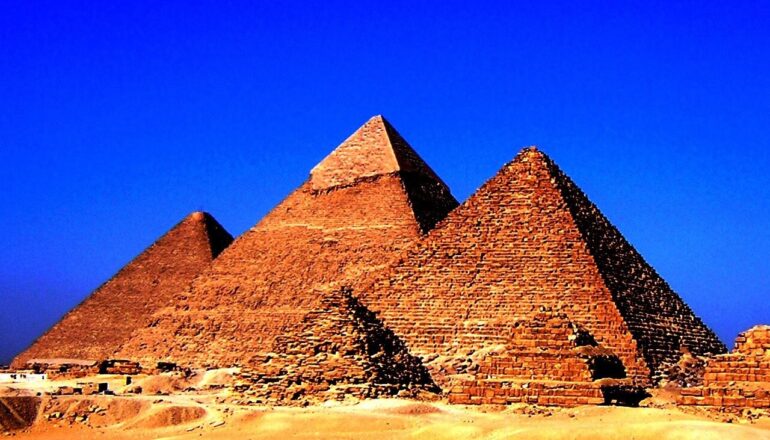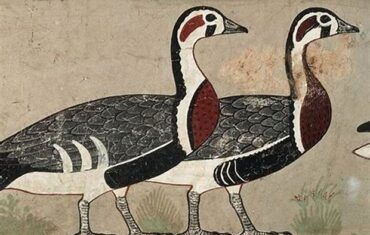The pyramids of Ancient Egypt were concrete expressions of specific beliefs about life in this and the world to come, determined in part by rural life along the Nilotic River basin, such as the cyclical experience of the annual flood.
One of the first Egyptian stories about Creation defines the original aspect of the existing world as a mound of mud emerging from the waters of the Primordial Ocean and the first form of life as a lotus growing on its top. For the Egyptians the lotus represents the god Nefertum, “perfect and complete”, who was venerated as the messenger of the sun because it rose from its petals to give life to the newly created world. The mud was also identified in a god called Tatjenen, “the emerging land”. The hill of earth or sand, inside the first temples, became a small monolithic pyramid called “BEN BN”, a name that derives from the root bn: “push up” or “push forward”. The BNBN was a concrete image of the first nucleus of earth that emerged from the waters, becoming a symbol not only of the primordial mound, but also of the sun, which rose from it. The Egyptian word, to indicate the rising of the sun, is derived from WBN BNBN, the addition of the prefix w indicates causative function…
The first Egyptian burials were usually surmounted by a rectangular structure of mud bricks known as the “mastaba”, inside which mounds of earth were sometimes found in correspondence with the burial chamber. The first pyramid tomb of King Djoser (III dynasty), at Saqqara, was initially a mastaba, converted to a six-step pyramid for having built five successive mastabas on it. The resulting shape was a variant of the primeval mound, imagined as a series of steps rather than a hill with gentle slopes: a characteristic found within the oldest mastaba in Saqqara. The classical pyramids that appeared, for the first time, in the IV dynasty, derived from the aforementioned prototype perfected through the filling of the steps and with flat and polished external surfaces, and even if on a monumental scale they represented the most common BNBN. Some new official tombs recently discovered from the same period, south of the three great pyramids of Giza, were topped by conical mounds, which undoubtedly served the same purpose as the royal pyramids and already represented another architectural realization of the primordial mound.
Transcending the connection that the pyramids had with the force of a new life, not much is known about their real role they played in the life of the king in the afterlife.
The imposing pyramids of the III and IV dynasty show successive changes and innovations in architecture and projects; this suggests an evolution in the speculation concerning their functions.
In the fourth dynasty, however, the layout of the rooms in the pyramids was canonized and the new arrangement undoubtedly reflected the vision of the afterlife that characterized Egyptian thought from then on
The typical plan of the late pyramids of the Old Kingdom consists of three main elements:
An antechamber, under the top of the pyramid, connected to the outside by means of a corridor that opened on the north face;
A burial chamber to the west of the antechamber;
A sarcophagus in the extreme west of the burial chamber.
Some of the features described were introduced in the fourth dynasty such as the stone sarcophagus in the pyramid of Khufu, the antechamber under the apex of the pyramid of Menkaure – but the canonical layout of all three elements did not appear until the end of the fourth dynasty, in the royal tomb built for King Shepseskaf, successor of Menkaure. In reality, the tomb is a mastaba rather than a pyramid, and this suggests a break with the royal funerary traditions that had characterized the burials since the time of King Djoser, 150 years earlier. The Shepseskaf tomb was deliberately designed to reflect the Mastabas of the first Egyptian kings in Abydos, an important cult center of Osiris, God of the Hereafter, in Upper Egypt. Osiris represented the force of a new life, which generated the mysterious process of birth, from apparently dormant entities such as from seeds planted in the ground. The god was also central to understanding the daily solar cycle. Each night the sun seemed to sink under the ground and die, but in the morning, he would return to the world again, to live once more during the day. The Egyptians believed that during the night, the dead sun received the power of a new energy based on a double interpretation: the sun returned in the womb of Nut, the goddess of the sky, during the night and was reborn between her thighs at dawn. or the sun entered the underworld, known as the Duat, where it identified itself with the mummy of Osiris, lying in the depths of the Duat, and received from that union the ability, once again, to return to life. Every night, when the sun entered Nut’s body and Duat, the king’s spirit would come back inside his tomb.
The stone sarcophagus at the extreme west of the burial chamber, which was a parallel to Nut’s womb, contained the king’s mummy, which became both the fetus and alter ego of Osiris lying in the Duat. The Texts of the Pyramids refer to the burial chamber as Duat, and the formulas carved there mention the king not only with his proper name, but also with the appellative of Osiris. Thus, as the sun was united with Osiris in the Duat, the spirit of the king was considered inseparable from the mummy inside the Duat symbolized by the burial chamber, and exactly like the sun, it received through this identification the capacity for a new rebirth. …)



